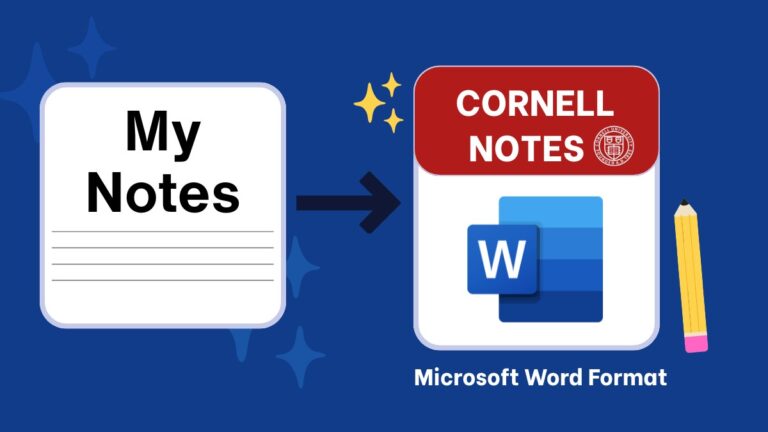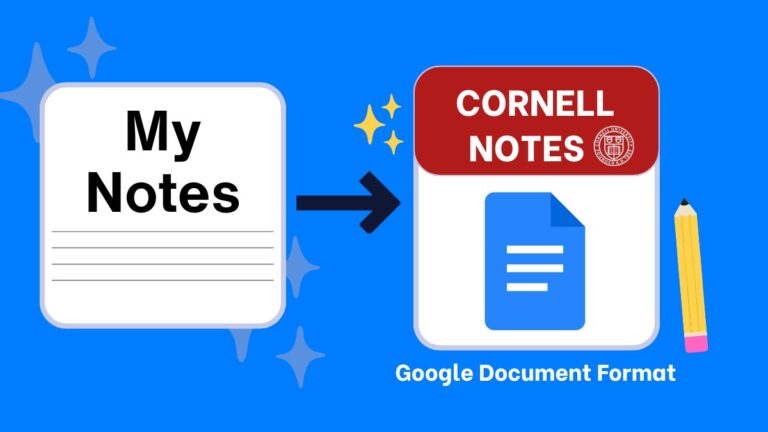Use these free transcript to notes prompts with ChatGPT to turn raw captions into clean, skimmable study notes. You get fast heading structure, de-noised text, and a glossary you can test. Research-backed guidance recommends transparent, responsible AI use in learning contexts U.S. Department of Education, 2023 and highlights cognitive strategies that promote retention Deans for Impact, 2023.
What Are Transcript Cleanup Student Prompts?
These prompts convert messy transcripts into organized notes with clear headings and key terms. They are for high school and college students, teachers, and professionals capturing lectures, webinars, or interviews. Unlike generic study prompts, these focus on structure, de-noising, and terminology extraction.
Explore related workflows like Lecture to Notes and Organized Notes. Try our free AI study-guide generator to turn cleaned transcripts into review sheets.
How to Use These AI Transcript Cleanup Prompts
Pick 3–5 prompts, paste your source (audio, captions, slides, PDF, or notes), then run the steps in ChatGPT or Gemini. Export the output to Google Docs or CSV when done. New to AI note-taking? Read the Get Started with AI Note Taking to easily get started.
Headings & Structure Prompts for Students (1–20)
Use these to impose a logical outline on noisy transcripts. You will segment topics, add hierarchical headings, and create readable sections that mirror learning objectives and timelines.
- Segment the transcript into sections with H1–H3 headings reflecting topic shifts.
- Insert a concise overview under each H2 summarizing main claims and evidence.
- Convert time-based transitions into subheadings labeled by concept rather than minute marks.
- Rewrite rambling segments into bullet paragraphs with one idea per bullet.
- Create a top-level outline that maps headings to the syllabus objectives provided.
- Add descriptive headings that include action verbs and the primary concept discussed.
- Group related subtopics into thematic clusters and name each cluster clearly.
- Split compound paragraphs into separate blocks for definition, example, and implication.
- Add a brief lead-in sentence under each heading explaining reader payoff quickly.
- Reorder sections to follow prerequisite logic from basics to applications.
- Insert “You should now know” checkpoints at the end of major sections.
- Flag tangents and move them into footnotes or an appendix section.
- Label each heading with estimated reading time based on token count.
- Merge duplicate headings and consolidate overlapping content into one canonical section.
- Add cross-links between sections where concepts depend on each other.
- Create a mini table of contents listing H2 and H3 anchors only.
- Ensure each heading answers a specific question the section will resolve.
- Normalize heading capitalization to sentence case for readability and consistency.
- Add a one-sentence takeaway at the end of each subsection’s content.
- Tag each section with keywords for quick search and later study guides.
Cleanup & Noise Removal Prompts (21–40)
Remove filler, correct common ASR mistakes, and standardize speaker cues. These prompts improve clarity without changing meaning, readying the text for study or sharing.
- Strip filler words and verbal tics while preserving technical terms and emphasis.
- Correct misheard domain terms using the supplied vocabulary list and context.
- Normalize units, symbols, and Greek letters to proper scientific notation.
- Standardize numbers, dates, and times using ISO formats or course conventions.
- Resolve unclear pronouns by replacing them with specific nouns from context.
- Fix punctuation and sentence boundaries introduced by automated captioning errors.
- Collapse repeated phrases from echo or stuttering into a single clear instance.
- Remove irrelevant small talk unless it introduces key concepts or instructions.
- Mark uncertain segments with [verify] and propose likely corrections with rationale.
- Normalize abbreviations and expand first mentions with full terms in parentheses.
- Detect and remove duplicate sentences caused by transcription overlap or merging.
- Standardize speaker tags to “Instructor,” “Student,” or named roles as provided.
- Convert shouted emphasis or ALL CAPS into bold markers in notes format.
- Flag off-the-record remarks and remove them from the distributable notes version.
- Identify and correct homophones by checking nearby technical context and units.
- Repair sentence fragments by joining them to the correct preceding clauses.
- Convert informal lists into numbered or bulleted lists with parallel structure.
- Mark redacted names or data with consistent placeholders and a privacy note.
- Standardize quotation formatting for cited passages mentioned in the transcript.
- Create a change log summarizing every cleanup decision and its justification.
Key Terms & Glossary Prompts (41–60)
Extract definitions, aliases, and common misconceptions. Build a glossary you can turn into flashcards or embed in study guides for quick retrieval practice.
- Extract key terms and provide one-sentence student-friendly definitions for each.
- List common aliases or abbreviations for each term with usage notes.
- Add contrast pairs: what the term is and what it is not.
- Provide a formula or canonical representation for terms with equations or syntax.
- Attach a simple example for each term that mirrors course context closely.
- Note frequent misconceptions and provide a corrective explanation in one line.
- Mark prerequisite terms that should be reviewed before learning each concept.
- Generate cloze deletions for key definitions for spaced recall practice.
- Map terms to syllabus outcomes and tag them by exam relevance level.
- Link terms that often co-occur and show their relationship in one sentence.
- Identify high-yield terms likely to appear on quizzes based on emphasis pattern.
- Provide multilingual synonyms for key terms where relevant to the course context.
- Extract entities like people, places, or datasets and add brief descriptors.
- Generate two-sentence plain-language expansions for advanced terms as tooltips.
- Label each term with example question stems for practice and self-testing.
- Create short analogies that connect abstract terms to familiar real-world processes.
- Note conflicting definitions and recommend the course-preferred version explicitly.
- List references or citations mentioned alongside each term if present.
- Propose glossary quiz items with definitions, distractors, and correct answers.
- Export the glossary as CSV with fields: term, definition, notes, tags.
Speakers, Timestamps, and Context Prompts (61–80)
Clarify who said what, when, and why it matters. These prompts align transcript moments with slides, demos, or assigned readings for cross-reference.
- Detect speakers and label role-based attributions consistently across the document.
- Insert timestamps at heading boundaries for quick jump navigation in playback.
- Link each section to the corresponding slide numbers provided in the deck.
- Tag live demos or board work segments with [demo] and brief outcomes.
- Mark Q&A sequences and summarize the instructor’s final answer succinctly.
- Add “[assignment]” tags where the instructor mentions tasks, due dates, or rubrics.
- Connect transcript sections to required readings with page references provided.
- Flag off-topic digressions and relocate them to an appendix with timestamps.
- Note exam hints and compile them into a dedicated high-yield checklist.
- Identify places where the instructor corrects earlier statements and clarify revisions.
- Mark safety notices, ethical guidance, or policy statements mentioned during class.
- Highlight definitions confirmed by the instructor as “exam language” to memorize.
- Summarize each 10-minute block into two bullets: concept and example.
- Add “[revisit]” tags where confusion remains and suggest clarifying questions to ask.
- Capture citations mentioned aloud and format them in APA and MLA styles.
- Mark references to figures, tables, or equations and list them per section.
- Label live corrections to slides and note the corrected version explicitly.
- Capture references to rubrics and link them to the assignment portal URL.
- Pull action items into a checklist with owners, due dates, and dependencies.
- Create a recap paragraph that references timestamp anchors for quick review.
Section Summaries & Highlights Prompts (81–95)
Turn structured notes into fast recall aids. Summaries, bullets, and must-know lists support spaced practice and exam prep across your course calendar.
- Produce a three-bullet summary per section: claim, support, implication.
- Highlight high-yield facts and mark them with ⭐ for spaced review cycles.
- Extract decision trees or procedures as stepwise checklists with inputs and outputs.
- Turn examples into exercise prompts with hidden answers for self-testing.
- List assumptions stated or implied, and note when each assumption can fail.
- Extract comparative tables mentioned verbally and present them as Markdown tables.
- Convert numeric examples into generalized formulas with variable annotations.
- Extract case studies and summarize context, intervention, and measured outcomes.
- Build a misconceptions list with corrections and links to relevant sections.
- Create “explain to a friend” paraphrases for each core idea in simple language.
- Generate two exam-style short-answer questions per section with answer keys.
- Produce a one-minute verbal recap script you can record for audio review.
- Identify diagrams referenced and draft caption text with labels and callouts.
- Summarize limitations or caveats the instructor noted and their practical impact.
- Create a “teach-back” checklist to verify understanding after reviewing notes.
Export, Formatting, and Next-Step Prompts (96–110)
Finalize your cleaned transcript for study or collaboration. Export to docs, spreadsheets, or decks and queue the next study actions automatically.
- Format headings and bullets in Markdown compatible with Google Docs import.
- Export a two-column glossary table with term and concise definition fields.
- Generate a slide-ready outline with one key idea per slide title.
- Create a study guide draft linking sections to glossary entries and examples.
- Produce a CSV of timestamps, headings, and slide references for tracking.
- Draft flashcards from glossary terms with cloze deletions for key facts.
- Generate a reading list from cited sources with annotated one-line takeaways.
- Create an action plan for confusing sections with targeted follow-up questions.
- Compose a one-page executive summary suitable for sharing with classmates.
- Prepare a quiz with five mixed-format questions per major section and answers.
- Draft Anki-compatible text for each term: front prompt and back answer.
- Convert key procedures into numbered how-to steps with required inputs first.
- Produce a condensed cheat sheet limited to 200 words of must-know points.
- Queue spaced-repetition review dates for starred items over 1–3–7–14–30 days.
- Suggest next tools: study guides, quizzes, or concept explainers based on gaps found.
Printable & Offline Options
Export cleaned notes to PDF for printing or offline review. Use the glossary CSV to create flashcards or attach to your LMS. For more printable sets, see the Student Prompts hub.
Related Categories
FAQ
What file types work best for transcript cleanup?
Paste raw text from .vtt, .srt, .docx, or copied captions. For PDFs, extract text first to preserve line breaks. Maintain timestamps separately if you plan to link back to video chapters.
How do I keep instructor intent while removing filler?
Use prompts that preserve technical terms and emphasis while removing tics. Add verification tags like [verify] for unclear segments and include a change log summarizing edits.
Can I turn cleaned transcripts into study guides automatically?
Yes. After headings and glossary extraction, feed the output to our free AI study guide generator to create summaries, questions, and practice tasks aligned to objectives.
How should I handle privacy or sensitive remarks?
Redact names and personal data, replace with placeholders, and move off-the-record comments to a private appendix. Keep a redaction note in the final document.
What’s the best way to track exam-relevant items?
Star high-yield facts and queue spaced reviews for 1–3–7–14–30 days. Convert starred items into flashcards or a checklist before the next class.
Final Thoughts
Clean transcripts become structured, searchable notes with clear headings and a testable glossary. Use the prompts above to streamline cleanup, improve comprehension, and speed exam prep. Want more? Start AI note taking instantly for free with our AI note taker.
References: U.S. Department of Education, 2023; Deans for Impact, 2023.



